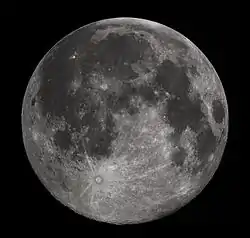List of lunar deities
In mythology, a lunar deity is a god or goddess of the Moon, sometimes as a personification. These deities can have a variety of functions and traditions depending upon the culture, but they are often related. Some form of Moon worship can be found in most ancient religions.

Moon in religion and mythology
The monthly cycle of the Moon, in contrast to the annual cycle of the Sun's path, has been implicitly linked to women's menstrual cycles by many cultures, as evident in the links between the words for menstruation and for Moon in many resultant languages,[1] though this identification was not universal as demonstrated by the fact that not all moon deities are female. Many well-known mythologies feature female lunar deities, such as the Greek goddess Selene, the Roman goddess Luna, and the Chinese goddess Chang'e.
Male lunar gods are also frequent, such as Sin of the Mesopotamians, Mani of the Germanic tribes, Tsukuyomi of the Japanese, and Igaluk/Alignak of the Inuit. The ancient Egyptians had several male moon gods, for example, Ibis and Khonsu of Thebes. Thoth was also a lunar deity, but his character is considerably more complex than Ibis and Khonsu.[2] Set represented the Moon in the Egyptian Calendar of Lucky and Unlucky Days of papyrus Cairo 86637.[3] These cultures usually feature female sun goddesses. An exception is Hinduism; featuring both male and female aspects of the solar divine.
The original Proto-Indo-European lunar deity appears to have been male.[4] Several goddesses, like Artemis or Hecate, did not originally have lunar aspects, and only acquired them late in antiquity, due to syncretism with Selene/Luna, the de facto Greco-Roman lunar deity. In traditions with male gods, there is little evidence of such syncretism, though the Greek Hermes has been equated with the male Egyptian lunar god Thoth. In Greece proper, remnants of male moon gods are also seen with Menelaus. Nyx is the goddess of night.
Also of significance is that many religions and societies are oriented chronologically by the Moon, as opposed to the Sun. One common example is Hinduism in which the word Chandra means "Moon" and has religious significance during many Hindu festivals (e.g. Karwa Chauth, Sankasht Chaturthi, and during eclipses). The ancient Germanic tribes were also known to have a lunar calendar.
The Moon features prominently in art and literature and also has a purported influence in human affairs, a belief that consistently remains a feature of astrology, though beliefs such as this are classified as pseudoscience.
List of moon deities
African
| Name | Image | Mythology / Religion | Details |
|---|---|---|---|
| Abuk | Dinka | Goddess of fertility, morality, creativity and love | |
| Ala | Igbo | Goddess of fertility, morality and creativity | |
| Gleti | Dahomean | ||
| Mawu | Dahomean | ||
| Iah | Egyptian | ||
| iNyanga | Zulu | Goddess of the Moon | |
| Khonsu | Egyptian | The god of the moon. A story tells that Ra (the sun God) had forbidden Nut (the Sky goddess) to give birth on any of the 360 days of the calendar. In order to help her give birth to her children, Thoth (the god of wisdom) played against Khonsu in a game of senet. Khonsu lost to Thoth and then he gave away enough moonlight to create 5 additional days so Nut could give birth to her five children. It was said that before losing, the moonlight was on par with the sunlight. Sometimes, Khonsu is depicted as a hawk-headed god, however he is mostly depicted as a young man with a side-lock of hair, like a young Egyptian. He was also a god of time. The centre of his cult was at Thebes which was where he took place in a triad with Amun and Mut. Khonsu was also heavily associated Thoth who also took part in the measurement of time and the moon. | |
| Thoth | Egyptian | God of wisdom, the arts, science, and judgment | |
| Ela-Opitan | Yoruba | ||
Europe
| Name | Image | Mythology / Religion | Details |
|---|---|---|---|
| Arianrhod | Welsh | ||
| Artemis |  |
Greek | Artemis is the ancient Greek goddess of the hunt, wilderness, wild animals, chastity, and the Moon.[5][6] She is the daughter of Zeus and Leto and the twin sister of Apollo.[7] She would eventually be extensively syncretized with the Roman goddess Diana. Cynthia was originally an epithet of the Greek goddess Artemis, who according to legend was born on Mount Cynthus. Selene, the Greek personification of the Moon, and the Roman Diana were also sometimes called "Cynthia".[8] |
| Artume | Etruscan | ||
| Ataegina |  |
Lusitanian | |
| Bendis | 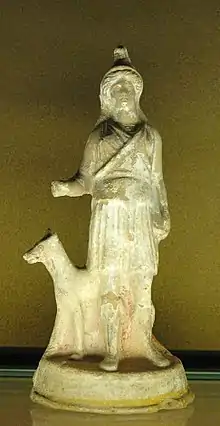 |
Thracian | |
| Diana | 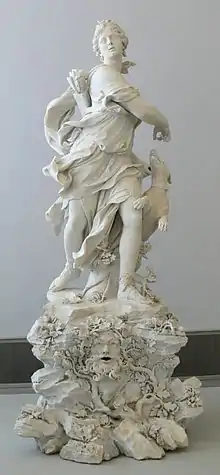 |
Roman | Diana is a goddess in Roman and Hellenistic religion, primarily considered a patroness of the countryside, hunters, crossroads, and the Moon. She is equated with the Greek goddess Artemis (see above), and absorbed much of Artemis' mythology early in Roman history, including a birth on the island of Delos to parents Jupiter and Latona, and a twin brother, Apollo,[9] though she had an independent origin in Italy. |
| Elatha | Irish | Elatha was a king of the Fomorians in Irish mythology. He succeeded his father Delbáeth and was replaced by his son Bres, mothered by Ériu. | |
| Hecate | 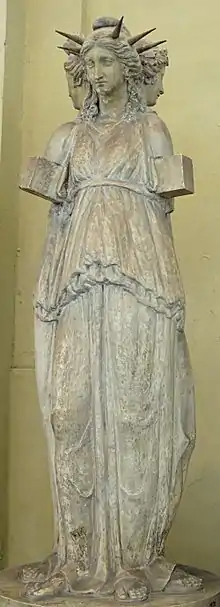 |
Greek | While associated with the Moon, Hecate is not actually considered a goddess of the moon. |
| Hors | Slavic | ||
| Hjúki and Bil | Norse | ||
| Ilargi | Basque | ||
| Kuu | Finnish | ||
| Losna | Etruscan | ||
| Luna | 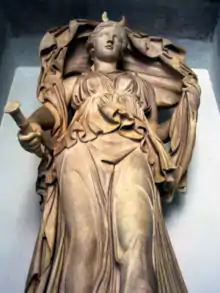 |
Roman | |
| Mano | Sámi | ||
| Máni | 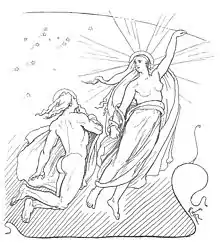 |
Norse | Máni is the personification of the Moon in Norse mythology. Máni, personified, is attested in the Poetic Edda, compiled in the 13th century from earlier traditional sources, and the Prose Edda, written in the 13th century by Snorri Sturluson. Both sources state that he is the brother of the personified sun, Sól, and the son of Mundilfari, while the Prose Edda adds that he is followed by the children Hjúki and Bil through the heavens. |
| Meness | Latvian | ||
| Phoebe | Greek | ||
| Selene |  |
Greek | |
| Triple Goddess | 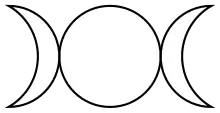 |
Wicca | |
Ainu mythology
- God Kunnechup Kamui
Anatolian
- God Kaskuh (Hittite mythology)
- God Men (Phrygian mythology)
Chinese mythology
- Jie Lin, God that carries the Moon across the night sky [10]
- Chang Xi Mother of twelve moons corresponding to the twelve months of the year
- Chang'e Immortal that lives on the Moon
- Tai yin xing jun (太陰星君 Tàiyīn xīng jūn ) of Investiture of the Gods in taoism and Chinese folk religion[11][12]
- Tu'er Ye Rabbit god that lives on the Moon
- Wu Gang Immortal that lives on the Moon
Elamite
- God Napir
Hindu Mythology

- God Chandra or Soma, The moon god
Hurro-Urartian
- God Kušuḫ (Hurrian mythology)
- Goddess Selardi (Urartian mythology)
Indonesian mythology
- Goddess Ratih
- Goddess Silewe Nazarate
Korean mythology
- Goddess Myeongwol[13]
Mari mythology
- God Tõlze
Philippine mythologies
- Kabigat (Bontok mythology): the goddess of the moon who cut of the head of Chal-chal's son; her action is the origin of headhunting[14]
- Bulan (Ifugao mythology): the moon deity of the night in charge of nighttime[15]
- Moon Deity (Ibaloi mythology): the deity who teased Kabunian for not yet having a spouse[16]
- Delan (Bugkalot mythology): deity of the moon, worshiped with the sun and stars; congenial with Elag; during quarrels, Elag sometimes covers Delan's face, causing the different phases of the moon; giver of light and growth[17]
- Bulan (Ilocano mythology): the moon god of peace who comforted the grieving Abra[18]
- Bulan (Pangasinense mythology): the merry and mischievous moon god, whose dim palace was the source of the perpetual light which became the stars; guides the ways of thieves[19]
- Wife of Mangetchay (Kapampangan mythology): wife of Mangetchay who gave birth to their daughter whose beauty sparked the great war; lives in the Moon[20]
- Mayari (Kapampangan mythology): the moon goddess who battled her brother, Apolaqui[21]
- Apûng Malyari (Kapampangan mythology): moon god who lives in Mount Pinatubo and ruler of the eight rivers[22]
- Mayari (Tagalog mythology): goddess of the moon;[23] sometimes identified as having one eye;[24] ruler of the world during nighttime and daughter of Bathala[25]
- Dalagang nasa Buwan (Tagalog mythology): the maiden of the moon[26]
- Dalagang Binubukot (Tagalog mythology): the cloistered maiden in the moon[27]
- Unnamed Moon God (Tagalog mythology): the night watchman who tattled on Rajo's theft, leading to an eclipse[28]
- Bulan-hari (Tagalog mythology): one of the deities sent by Bathala to aid the people of Pinak; can command rain to fall; married to Bitu-in[29]
- Bulan (Bicolano mythology): son of Dagat and Paros; joined Daga's rebellion and died; his body became the Moon;[30] in another myth, he was alive and from his cut arm, the earth was established, and from his tears, the rivers and seas were established[31]
- Haliya (Bicolano mythology): the goddess of the moon[32]
- Libulan (Bisaya mythology): the copper-bodied son of Lidagat and Lihangin; killed by Kaptan's rage during the great revolt; his body became the moon[33]
- Bulan (Bisaya mythology): the moon deity who gives light to sinners and guides them in the night[34]
- Launsina (Capiznon mythology): the goddess of the Sun, Moon, stars, and seas, and the most beloved because people seek forgiveness from her[35]
- Diwata na Magbabaya (Bukidnon mythology): simply referred as Magbabaya; the good supreme deity and supreme planner who looks like a man; created the Earth and the first eight elements, namely bronze, gold, coins, rock, clouds, rain, iron, and water; using the elements, he also created the sea, sky, Moon, and stars; also known as the pure god who wills all things; one of three deities living in the realm called Banting[36]
- Bulon La Mogoaw (T'boli mythology): one of the two supreme deities; married to Kadaw La Sambad; lives in the seventh layer of the universe[37]
- Moon Deity (Maranao mythology): divine being depicted in an anthropomorphic form as a beautiful young woman; angels serve as her charioteers[38]
Semitic mythology
- God Aglibol (Palmarene mythology)
- God Baal-hamon (Punic religion)
- God Sin (Mesopotamian mythology)
- God Ta'lab (Arabian mythology)
- God Wadd (Minaean mythology)
- God Yarikh (Canaanite mythology)
Austronesian
- God Andriambahomanana (Malagasy mythology)
- Goddess Lona (Hawaiian mythology)
- God Avatea (Polynesian mythology)
- God Fati (Polynesian mythology)
- Goddess Hina (Polynesian mythology)
- Goddess Mahina (Polynesian mythology)
- God Marama (Polynesian mythology)
Australia
- God Bahloo (Australian Aboriginal mythology)
- God Kidili (Mandjindja mythology)
- God Ngalindi (Yolngu mythology)
Aztec mythology
- Goddess Coyolxauhqui
- Goddess Metztli
- God Tecciztecatl (see Metztli)
Cahuilla mythology
- Goddess Menily[39]
Hopi mythology
- God Muuya
Incan mythology
- Goddess Mama Killa
- Goddess Ka-Ata-Killa
- God Coniraya
Inuit mythology
- God Alignak
- God Igaluk
- God Tarqiup Inua
Lakota mythology
- Goddess Hanwi
Maya mythology
- Goddess Awilix; Xbalanque was her mortal (male) incarnation
- Maya moon goddess
Pawnee mythology
- God Pah
Tupi Guarani mythology
- God Abaangui
- Goddess Arasy
- God/Goddess Jasy (gender depends on tribe)
Voodoo
- God Kalfu
See also
References
- Harding, Esther M., 'Woman's Mysteries: Ancient and Modern', London: Rider, 1971, p. 24.
- Thoth, the Hermes of Egypt: a study of some aspects of theological thought in ancient Egypt, page 75
- Jetsu, L.; Porceddu, S. (2015). "Shifting Milestones of Natural Sciences: The Ancient Egyptian Discovery of Algol's Period Confirmed". PLOS ONE. 10 (12): e.0144140 (23pp). arXiv:1601.06990. Bibcode:2015PLoSO..1044140J. doi:10.1371/journal.pone.0144140. PMC 4683080. PMID 26679699.
- Dexter, Miriam Robbins. Proto-Indo-European Sun Maidens and Gods of the Moon. Mankind Quarterly 25:1 & 2 (Fall/Winter, 1984), pp. 137–144.
- Shen (2018), p. 60
- Sacks (1995), p. 35
- Neils (2003), p. 117
- Pannen, p. 96.
- Larousse Desk Reference Encyclopedia, The Book People, Haydock, 1995, p. 215.
- 太上洞真五星秘授经
- Overmyer (1986), p. 51.
- Fan, Chen 2013. p. 23
- Seo, Dae Seok. "Song of Sun and Moon". Encyclopedia of Korean Folk Culture. Retrieved November 24, 2020.
- Jenks, A. (1905). The Bontoc Igorot. Manila: Bureau of Printing.
- Bimmolog, H., Sallong, L., Montemayor, L. (2005). The Deities of the Animistic Religion of Mayaoyao, Ifugao.
- Moss, C. R. (1924). Nabaloi Tales. University of California Publications in American Archaeology, 227–353.
- Wilson, L. L. (1947). Ilongot Life and Legends. Southeast Asia Institute.
- Alacacin, C. (1952). The Gods and Goddesses. Historical and Cultural Data of Provinces.
- Eugenio, D. L. (2007). Philippine Folk Literature: An Anthology. University of the Philippines Press.
- Jose, V. R. (1974). Creation and Flood Myths in Philippine Folk Literature. UP .
- Fansler, D. S. (1921). 1965 Filipino Popular Tales. Hatboro, Pennsylvania: Folklore Assosciates Inc.
- Nicdao, A. (1917). Pampangan Folklore. Manila.
- Calderon, S. G. (1947). Mga alamat ng Pilipinas. Manila : M. Colcol & Co.
- Jocano, F. L. (1969). Philippine Mythology. Quezon City: Capitol Publishing House Inc.
- Ramos, M. (1990). Philippine Myths, Legends, and Folktales. CreateSpace Independent Publishing Platform
- Pardo, F. (1686–1688). Carte [...] sobre la idolatria de los naturales de la provincia de Zambales, y de los del pueblo de Santo Tomas y otros cicunvecinos [...]. Sevilla, Spain: Archivo de la Indias.
- Pardo, F. (1686–1688). Carte [...] sobre la idolatria de los naturales de la provincia de Zambales, y de los del pueblo de Santo Tomas y otros cicunvecinos [...]. Sevilla, Spain: Archivo de la Indias.
- Beyer, H. O. (1912–30). H. Otley Beyer Ethnographic Collection. National Library of the Philippines.
- Eugenio, D. L. (2013). Philippine Folk Literature: The Legends. Quezon City: University of the Philippines Press
- Beyer, H. O. (1923). Ethnogrphy of the Bikol People. vii.
- Arcilla, A. M. (1923). The Origin of Earth and of Man. Ethnography of the Bikol People, vii.
- Tiongson, N. G., Barrios, J. (1994). CCP Encyclopedia of Philippine Art: Peoples of the Philippines. Cultural Center of the Philippines.
- Miller, J. M. (1904). Philippine folklore stories. Boston, Ginn.
- Buyser, F. (1913). Mga Sugilanong Karaan.
- Cruz-Lucero, R., Pototanon, R. M. (2018). Capiznon. With contributions by E. Arsenio Manuel. In Our Islands, Our People: The Histories and Cultures of the Filipino Nation, edited by Cruz-Lucero, R.
- Unabia, C. C. (1986). THe Bukidnon Batbatonon and Pamuhay: A Socio-Literary Study. Quezon City : UP Press.
- Casal, G. (1978). The T'boli Creation Myth and Religion. T'boli Art: in its Socio-Cultural Context, pp. 122–123
- Talaguit, C. J. N. (2019). Folk-Islam in Maranao Society. History Department, De La Salle University – Manila.
- "Menily, the Cahuilla moon goddess (Menilly, Menil, Man-El)". www.native-languages.org. Retrieved 2020-12-11.
Bibliography
- Neils, Jennifer; Oakley, John H. (August 11, 2003). Coming of Age in Ancient Greece: Images of Childhood from the Classical Past. Hanover, New Hampshire, United States: Hood Museum of Art. ISBN 978-0300099591.
- Rees, Alwyn; Rees, Brinley (1961). Celtic Heritage: Ancient Tradition in Ireland and Wales. High Holborn, London, England: Thames & Hudson. Retrieved August 14, 2019.
- Sacks, David (January 1, 1995). Murray, Oswyn (ed.). A Dictionary of the Ancient Greek World. Oxford, England, United Kingdom: Oxford University Press. ISBN 978-0195112061.
- Shen, Ann (April 3, 2018). Legendary Ladies: 50 Goddesses to Empower and Inspire You. San Francisco, United States: Chronicle Books. ISBN 978-1452163413. Retrieved August 14, 2019.
- Harley, Timothy. Moon Lore. London: S. Sonnenschein [etc.], 1885. pp. 77-139.
External links
| Wikimedia Commons has media related to Lunar deities. |
